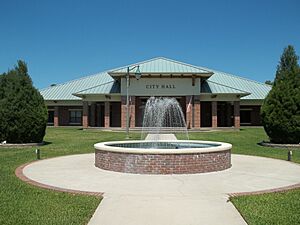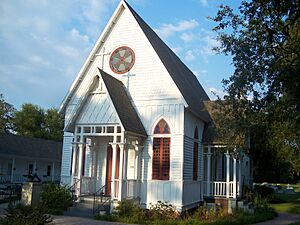Fruitland Park, Florida facts for kids
Quick facts for kids
Fruitland Park, Florida
|
|
|---|---|
| City of Fruitland Park | |
 |
|
| Motto(s):
The Friendly City
|
|

Location in Lake County and the state of Florida
|
|
| Country | United States of America |
| State | Florida |
| County | Lake |
| Incorporated | May 25, 1927 |
| Government | |
| • Type | Commission-Manager |
| Area | |
| • Total | 7.27 sq mi (18.82 km2) |
| • Land | 6.96 sq mi (18.03 km2) |
| • Water | 0.30 sq mi (0.79 km2) |
| Elevation | 66 ft (20 m) |
| Population
(2020)
|
|
| • Total | 8,325 |
| • Density | 1,195.61/sq mi (461.63/km2) |
| Time zone | UTC-5 (Eastern (EST)) |
| • Summer (DST) | UTC-4 (EDT) |
| ZIP code |
34731
|
| Area code(s) | 352 |
| FIPS code | 12-24975 |
| GNIS feature ID | 2403668 |
Fruitland Park is a city in Lake County, Florida, United States. It is part of the Orlando–Kissimmee–Sanford Metropolitan Statistical Area. The population was 8,325 at the 2020 census.
Contents
History

Fruitland Park antedates the American Civil War, although the name of the town only came later, as it was originally called Gardenia. The earliest settler was M. Calvin Lee, of the Evander Lee family of Leesburg, who planted a citrus grove. After the war, a son-in-law of the Lee family, P.S. Bouknight, homesteaded 40 acres (160,000 m2) near Mirror Lake.
In 1875, the State of Florida sent Captain Kendricks to the northern part of the United States to talk about the advantages of living in Florida. Due to Major Orlando P. Rooks' poor health, and already considering a move, he had his wife, Josephine, moved to Fruitland Park. They built their first home on Crystal Lake in 1877. It was here that the first white child, Frederic, was born in 1882.
The Fruitland Nurseries of Augusta, Georgia, was owned by J. P. Berckmann, friend of Major Rook. Major Rook named the town Fruitland Park for the nurseries, and the main street Berckmann Street for this friend.
The postal authorities refused to recognize the name Fruitland Park as there was already a Fruitland in the state. At their request, the name was changed to Gardenia in 1884. The Florida Railroad, put through the town just prior to this, had listed the town as Fruitland Park in all their printed matter and refused to recognize the new name of Gardenia. Consequently, all freight and express had to be directed to Fruitland Park and all mail addressed to Gardenia. This caused a great deal of confusion, which lasted from 1884 to 1888, when a petition was sent to the postal authorities to have the name changed back to Fruitland Park. The petition was granted in 1888.
On December 20, 1884, Rev. G.W. Butler organized the first "community" church in Fruitland Park, it was called the Community Church a Methodist Episcopal church founded by the Illinois conference. The church had acquired lots on College Ave., between Fountain St. and Lime St. The church was built in 1886–1887. That building burned in 1934, but was rebuilt in 1935. That building was later sold to the United Pentecostal Church and still remains today.
Fruitland Park was granted a charter by the state, and incorporated on May 25, 1927.
Fruitland Park is also home to the oldest Dirt Kart Track in America. The 1/8 mile clay oval kart track has hosted Saturday Night Dirt Kart Racing for Go Kart enthusiasts since opening in 1958.
Expansion of The Villages
On December 10, 2013, The Villages of Lake-Sumter Inc. closed on a deal to purchase property in Fruitland Park for $8 million from a private owner. Subsequently, they also began the annexation and rezoning process with the city. The property is currently the construction site for 2,038 new Villages homes, a project with final completion projected sometime in 2016. It was determined that the city of Fruitland Park stands to earn approximately $13 million in impact fees and building permits as a result of the expansion, not including ongoing tax revenues upon completion.
Geography
Fruitland Park is located at 28°51′31″N 81°54′47″W / 28.858571°N 81.913114°W.
According to the United States Census Bureau, the city has a total area of 9.5 km2 (3.7 sq mi), of which 7.6 km2 (2.9 sq mi) is land and 1.9 km2 (0.73 sq mi) (20.44%) is water.
Demographics
| Historical population | |||
|---|---|---|---|
| Census | Pop. | %± | |
| 1930 | 270 | — | |
| 1940 | 362 | 34.1% | |
| 1950 | 551 | 52.2% | |
| 1960 | 774 | 40.5% | |
| 1970 | 1,359 | 75.6% | |
| 1980 | 2,259 | 66.2% | |
| 1990 | 2,754 | 21.9% | |
| 2000 | 3,186 | 15.7% | |
| 2010 | 4,078 | 28.0% | |
| 2020 | 8,325 | 104.1% | |
| U.S. Decennial Census | |||
2010 and 2020 census
| Race | Pop 2010 | Pop 2020 | % 2010 | % 2020 |
|---|---|---|---|---|
| White (NH) | 3,234 | 6,555 | 79.30% | 78.74% |
| Black or African American (NH) | 373 | 630 | 9.15% | 7.57% |
| Native American or Alaska Native (NH) | 7 | 22 | 0.17% | 0.26% |
| Asian (NH) | 57 | 144 | 1.40% | 1.73% |
| Pacific Islander or Native Hawaiian (NH) | 13 | 18 | 0.32% | 0.22% |
| Some other race (NH) | 4 | 39 | 0.10% | 0.47% |
| Two or more races/Multiracial (NH) | 77 | 225 | 1.89% | 2.70% |
| Hispanic or Latino (any race) | 313 | 692 | 7.68% | 8.31% |
| Total | 4,078 | 8,325 |
As of the 2020 United States census, there were 8,325 people, 3,755 households, and 2,639 families residing in the city.
As of the 2010 United States census, there were 4,078 people, 1,385 households, and 1,008 families residing in the city.
Notable People
- Lillian Vickers-Smith, first female sports editor in the United States
See also
 In Spanish: Fruitland Park para niños
In Spanish: Fruitland Park para niños

